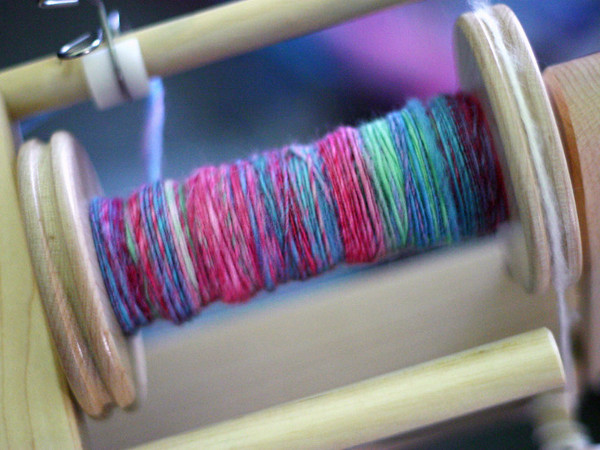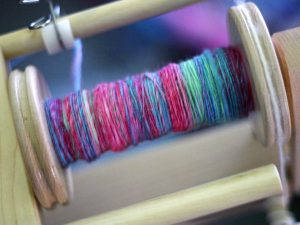Pic: Kate Henderson, CC BY-NC-ND 2.0
“I would make the spinning-wheel the foundation on which to build a sound village life.” – Mahatma Gandhi
Contents
What is spinning?
Spinning is creating yarn from fibre; it could be fleece straight from a sheep, or fibre that you’ve bought, dyed or undyed. As well as sheep’s wool, the fibre could be silk, alpaca, mohair, or plant fibres such as cotton, flax, ramie (nettle fibre), hemp – anything that can be spun. The yarn can then be used in a range of ways (depending on how it’s spun): gossamer lace for a shawl; novelty or chunky yarns for knitting, crochet or weaving; or rope from flax or hemp.

Hand spindles
Spinning has been around forever, in all parts of the world. All ancient cultures used some sort of hand spindle for creating yarns. A hand spindle is basically a stick with a disc attached. The disc makes the stick spin for longer. In prehistory, discs would be made of stone. They could be taken off and attached to another stick. The Navajo spindle has a 3ft wooden shaft, one end of which is rested on the floor, and the other end on the user’s leg. It is then spun by rolling along the thigh. At the other extreme, there is a tiny hand spindle made of brass, called a takhi. Most spindles are made of wood.
You use a spindle by twisting a bit of fibre around it, then holding the fibre and spinning the spindle – by hand, by foot, or by rolling it off the thigh. Then as the twisted yarn is produced, you attach more fibre to the end of it, and it is twisted and rolled onto the spindle. The twisting is what holds the yarn together.

You can spin using a hand spindle whilst you’re doing something else. You can be in a meeting or socialising, or even feeding chickens etc; and you’re mobile. With a wheel, you have to be sitting in your house. So in traditional societies, the hand spindle is still popular.
Spinning wheels
Wheels came later. The hand spindle was turned on its side and attached to a wheel to turn it. On a spinning wheel there is a separate bobbin (a reel for collecting the yarn) that moves independently of the spindle, which means that the spinner doesn’t have to keep stopping to wind the yarn on. There are two different kinds of wheels. There is the traditional spinning wheel where yarn is taken into the wheel through a hole in the bobbin. The second type is the ‘point of contact’ wheel, which has a point that sticks out. The yarn is held at an angle, and the twist is put into it off the point of the spindle.

The ‘great wheel’ and charkha are examples of point of contact wheels; they are faster than traditional wheels and tend to be used for finer threads. Gandhi used a charkha – a good wheel for spinning very fine yarns like cotton. In Britain they used the great wheel, which worked in a similar way, but was much bigger than the tiny charkha.
The spinning jenny was invented towards the end of the 18th century. The operator turns a handle that rotates 12 spindles simultaneously. Large factories sprang up in the north of England producing huge amounts of yarn, and almost all home workers using single-spindle wheels were put out of business. Most yarns nowadays are made on massive modern versions of the spinning jenny.
Carding is a process that untangles raw fibres and alings them so that they are parallel, and ready for spinning. This video is from our online course on how to spin.
What are the benefits of spinning?
- If you know how to spin, you can make beautiful yarns yourself that would be very expensive, or even impossible to buy
- If you have your own sheep, goats, alpacas or angora rabbits, you can spin your own yarn from your own fibre
- There are social networks of spinning groups; you can go to many places in the world and plug into a Weavers, Spinners & Dyers Guild group
- You can produce garments with a very small eco-footprint; you can use local, organic fibres, and dye them using natural dyes
- It’s a very interesting hobby, and a way of producing garments without feeding the exploitative and wasteful fashion industry
- Spinning can be a form of meditation, and have health benefits
- It’s fun, and children can learn to do it too

What can I do?
First, learn as much as you can. Here’s our free online course on all aspects of spinning. The tutor is Janet Renouf-Miller of Create With Fibre.
Maybe try spinning using a hand spindle first to see if you enjoy it. Traditional wheels cost from £300 new, and £90 second-hand (sometimes available from spinning groups or via the Spinners, Weavers & Dyers Guild website).
After you’ve obtained your fibre, you usually have to card it (although alpaca, angora and some wools don’t need to be carded). Carding means aligning and separating fibres by combing with special brushes (carders) which produces a much smoother fibre to work with. You can buy fibres ready-carded from online suppliers.
From sheep to sweater in less than ten minutes.
The main 3 fibre types are vegetable fibres such as cotton or linen; silk, which stands alone as a unique fibre spun by the moth of the silk worm; and animal fibres such as wool or alpaca. If you know someone with sheep, you can get fleeces very cheaply; and they are often given away. Then you can card it yourself and start spinning.
As a rough guide, once you’ve learnt to spin, it takes around 10 hours to spin the yarn required to make an adult’s jumper. But when you’re spinning, you can also be reading a book, watching a movie or listening to the radio. Blind people can spin, as can old or infirm people. Spinning and weaving have been used in therapeutic ways such as in occupational therapy. It’s not used so often nowadays (partly because there are not so many occupational therapists who can spin or weave).

After you’ve made your yarn, you can weave with it, or knit or crochet. If you want to make something special, you can copy a type of yarn you’ve seen somewhere, or spin something unique. You can dye your fibre, yarn or finished item. And you can even spin your cat’s or dog’s hair (or other pets), as long as the hair is long or fluffy!
Specialist(s)
Thanks to Janet Renouf-Miller of Create With Fibre for information.
The specialist(s) below will respond to queries on this topic. Please comment in the box at the bottom of the page.

Janet Renouf-Miller runs Create with Fibre, and is a registered teacher with the Association of Weavers Spinners and Dyers and has taught at their renowned Summer School. Janet has also taught courses for many spinning and weaving Guilds, knitting groups, shops and voluntary organisations. She is the author of How to Spin (just about anything) and our online course tutor.



3 Comments
Thank you Janet,I have been spinning for a while, kind of self taught and your course helped me a lot.A good fine tuning.
Hi
This is is a question for Janet about spinning.
Hi Janet
I’m so enjoying my spinning – I can’t believe how much fun it is to do badly (!)
My problem is that I’ve only got one bobbin at the moment – I’ve ordered some more but in the meantime I need to do something with the single ply I’ve made so as to free up the one bobbin I have so I can do more spinning!!
Could I wind it into a ball do you think? Or round the back of a chair ? I’m not sure how to keep the twist in it?
How you can help
Helen xx
Hi Helen you can wind the yarn into a ball, spin a second bobbin full, wind that into a ball as well. put the two balls one either side of you on the floor, and simply allow them to roll around and unwind as you ply them together onto your bobbin. this works better than putting them in containers as they will come out and get tangled up.